![]() Follis types of the First Tetrarchy, 293-305 CE
Follis types of the First Tetrarchy, 293-305 CE
In March 293 Diocletian and Maximan, the Augusti at the time, created the "First Tetrarchy" ("four rulers") by elevating Constantius and Galerius to become Caesars. It ended with the retirements of Diocletian and Maximian in May 305. Diocletian's coin reform of c. 294 introduced the "follis" (a.k.a. "nummus") denomination. This page is only about the follis denomination. The main page is an overview of all their coinage.
At first the only follis type was GENIO POPVLI ROMANI, issued at 14 mints. It is, by far, the most common type. After prices increased alarmingly, in 301 Diocletian promulgated his "Edict on Maximum Prices" and a new type, SACRA MONETA AVGG ET CAES NOSTR, was issued at 5 mints while the GENIO type continued to be struck. All the types are discussed next.
The coin at the upper right is a follis of Diocletian with his protecting god, Jupiter (discussed below).
The follis types of 294-305: (Link are to images further down this page). Only two types were issued at more than one mint.
1) GENIO POPVLI ROMANI (Here), Genius standing left holding patera and cornucopia.
There are many varieties from 14 mints. This was the initial type, is by far the most common, and it continued after the Edict. [Discussed below, with many more on pages devoted to the type.]
2) Moneta standing left, holding balance and cornucopia (Here) This is the second-most-common type, issued from 5 mints at about the time of the Edict.
SACRA MONETA AVGG ET CAESS NOSTR. It is common from Aquileia, Ticinum, and Siscia. There are numerous similar varieties, including
SACRA MONETA VRB AVGG ET CAES NOSTR, also abbreviated S M VRB ... from Rome,
MONETA SACRA AVGG ET CAESS NOSTR and M SACRA ... from Trier, but with the first two words reversed, and
MONETA AVGG ET CAESS NN (omitting SACRA) from Siscia and MONETA S AVGG ET CAESS NN from Trier.
[Discussed below. For many more, see their own page.]
The other follis types of 294-305 were each issued at only one mint.
Trier issued GENIO POPVLI ROMANI and SACRA MONETA and
FORTVNA types, Trier mint only, with Fortuna holding rudder and cornucopia, and either
3) Fortuna seated left (Here), or
4) Fortuna standing left (Here).
Fortuna types also have their own page, "Roman Coins with Fortuna."
Carthage issued three types unique to the Carthage mint (It did not issue the empire-wide types):
5) FELIX ADVENT AVGG NN (Here), Africa standing holding standard and elephant tusk
6) SALVIS AVGG ET CAESS FEL KART (Here), Carthage standing in long robe, holding fruits in each hand
7) SALVIS AVGG ET CAESS AVCTA KART (Here), same type as previous
Cyzicus issued GENIO POPVLI ROMANI (but not SACRA MONETA) and
8) GENIO AVGG ET CAESARVM NN (Here), Genius standing left (only for the Caesars, Constantius and Galerius)
Alexandria issued GENIO POPVLI ROMANI (but not SACRA MONETA) and
9) IOVI CONS CAES (Here), Jupiter standing (only for Diocletian and Galerius, eastern rulers)
10) HERCVLI VICTORI (Here), Hercules standing (only for Maximian and Constantius, western rulers) [This type was also issued later at Siscia under the Second Tetrarchy]
Other follis types after 305. All four members of the First Tetrarchy have other types of folles issued after the First Tetrarchy ended in 305. Diocletian and Maximian have retirement types and Maximian has types for his second reign. Constantius and Galerius have Second-Tetrarchy types issued after they became Augusti in 305.
Type 1: GENIO POPVLI ROMANI. This type is very common and has its own pages. Here is one.
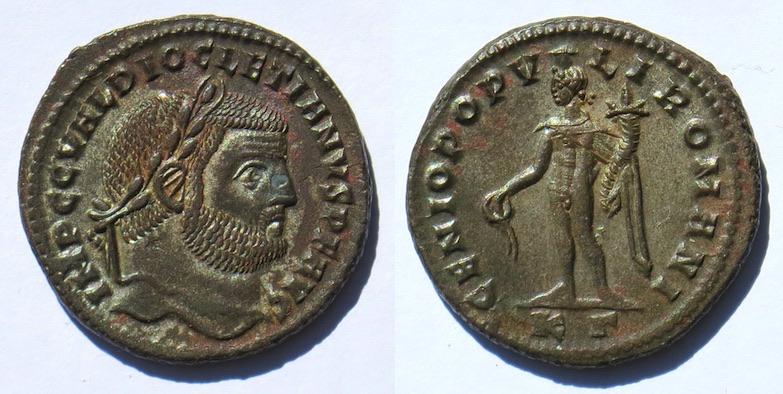
Diocletian
27 mm. 9.78 grams.
IMP C D VAL DIOCLETIANVS PF AVG
GENIO POPVLI ROMANI, Genius standing left, naked but for chalymis, holding patera and cornucopia.
KΓ in exergue
RIC Cyzicus 12a "c. 295-296"
This type was issued for all four rulers from 14 mints.
Type 2: Moneta standing left, holding balance and cornucopia. Main legend: SACRA MONETA AVGG ET CAES NOSTR.
SACRA MONETA folles have their own page. Here are two:
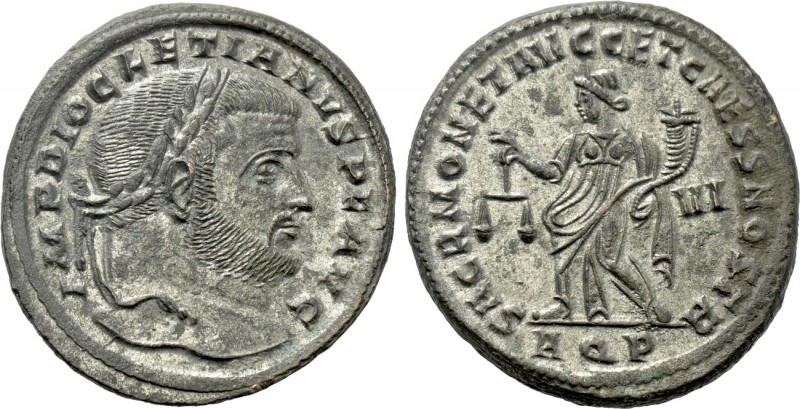
Diocletian
28-27 mm. 10.05 grams.
IMP DIOCLETIANVS PF AVG
Laureate head right
SACR MONET AVGG ET CAESS NOSTR
Moneta standing left, holding balance and cornucopia.
VI
AQP
RIC Aquileia 35a. "c. 302-3".
This type comes with several minor spelling abbreviations. This example has SACR MONET for the full SACRA MONETA .
Some issues have the first two words reversed: MONETA SACRA.
It was issued for all four rulers from numerous mints.

Constantius
28 mm. 11.42 grams.
FL VAL CONSTANTIVS NOB C
Laureate, curiassed, bust right
M•SACRA AVGG ET CAESS NN
*
BTR in exergue
This has the same design as the previous coin, however with the legend abbreviated and reordered so the usual SACRA MONETA is rendered M•SACRA.
RIC Trier 481a "c. 300-1".
Trier, Type 3. Fortuna seated. FORTVNA types have their own page.

Diocletian, Augustus 284-305 AD
28-27 mm. 7.99 grams.
IMP DIOCLETIANVS PF AVG
Laureat head right.
FORTVNAE REDVCI AVGG NN
Fortuna seated left holding rudder and cornucopia.
B in left field, * in right field, TR in exergue.
Struck at Trier (Treveri) [Now in Germany]
c. 298-299 AD.
RIC Trier 230a.
Failmezger 2.
Fortuna was the Italian goddess of chance or luck in the sense of good fortune, bad fortune, and the future. She contributes to steering the course of events, hence the rudder. Good fortune brings abundance, hence the cornucopia. Our terms "fortunate" and "fortune teller" derive from Fortuna. Fortuna REDVX is her aspect relating to a safe return from trips. The Greek "Tyche" is a similar goddess considered the eastern Greek equivalent of Fortuna. Many Roman provincial coins from eastern Greek cities illustrate the Tyche of the city with a turretted head. However, they do not name "Tyche" the way Roman coins name Fortuna.
Trier, Type 4. Fortuna standing. FORTVNA types have their own page.

Galerius
30-27 mm. 9.97 grams.
IMP MAXIMIANVS NOBIL CAESS
Laureate head right.
FORTVNAE REDVCI CAESS NN
Fortuna standing left, holding rudder and cornucopia, with globe at her feet.
* in field right. BTR in exergue.
RIC Trier 414b. "c. 298-299."
Failmezer 4.
Carthage, Type 5. FELIX ADVENT AVGG NN, Carthage standing, with elephant-skin headdress, holding standard and elephant tusk.
The Carthage mint was not open when the coinage was reformed. It was opened by Maximian in 296 when he crossed into Africa to campaign against tribes that had broken through the frontier. Each of its three follis types was issued for all four rulers, but the type really belongs to Maximian.
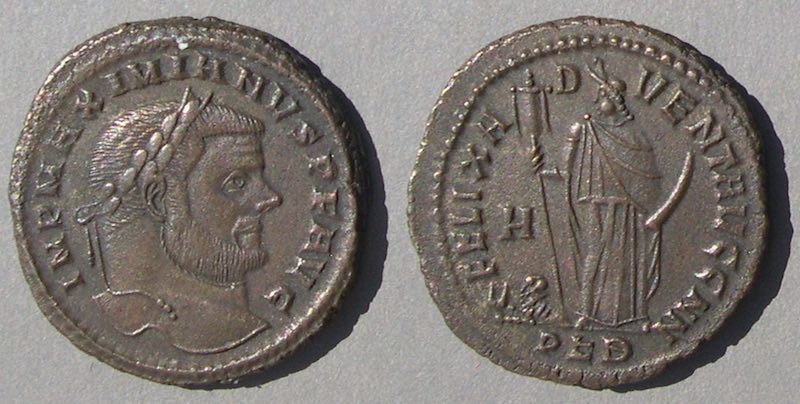
Maximian
28 mm. 9.84 grams.
FELIX ADVENT AVGG NN
(Happy arrival of our emperors)
Carthage standing, with elephant-skin headdress, holding standard and elephant tusk, tiny lion feeding on bull below left.
H
PKB
RIC VI Carthage 25B, struck 298, "wholly peculiar to Carthage" with reference to Maximian's arrival there in 297.
(There is a page on types celebrating arrivals, but it is not devoted to the tetrarchy.)
Alexandria, Type 6, SALVIS AVGG ET CAESS FEL KART, Carthage standing in long robe, holding fruits in each hand

Maximian
29-27 mm. 9.82 grams.
IMP MAXIMIANVS PF AVG
Laureate head right
SALVIS AVGG ET CAESS FEL KART,
Carthage standing in long robe, head left, holding fruits in each hand
RIC Carthage 27b "c. 298-9" (This type was continued in later issues.)
Alexandria, Type 7, SALVIS AVGG ET CAESS AVCTA KART, the same type with a different legend.
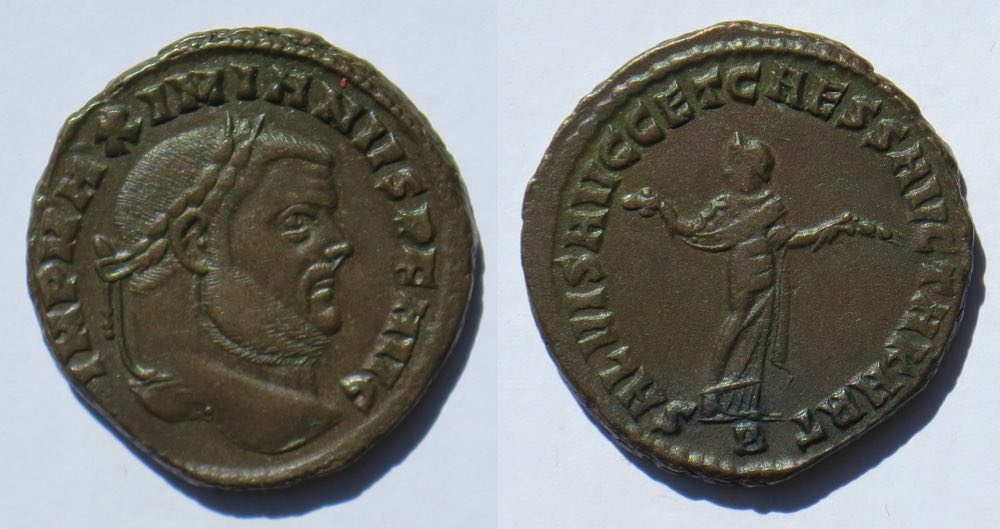
Maximian
27 mm. 9.64 grams.
IMP MAXIMIANVS PF AVG
Laureate head right
SALVIS AVGG ET CAESS AVCTA KART,
Carthage standing in long robe, head left, holding fruits in each hand
AVCTA = enriched and improved
RIC Carthage 27b. "c. 298-9".
"AVCTA KART" is much rarer than "FEL KART".
Cyzicus, Type 8. GENIO AVGG ET CAESARVM NN, only for the Caesars, Constantius and Galerius. The design is like the GENIO POPVLI ROMANI design but the legend is different.
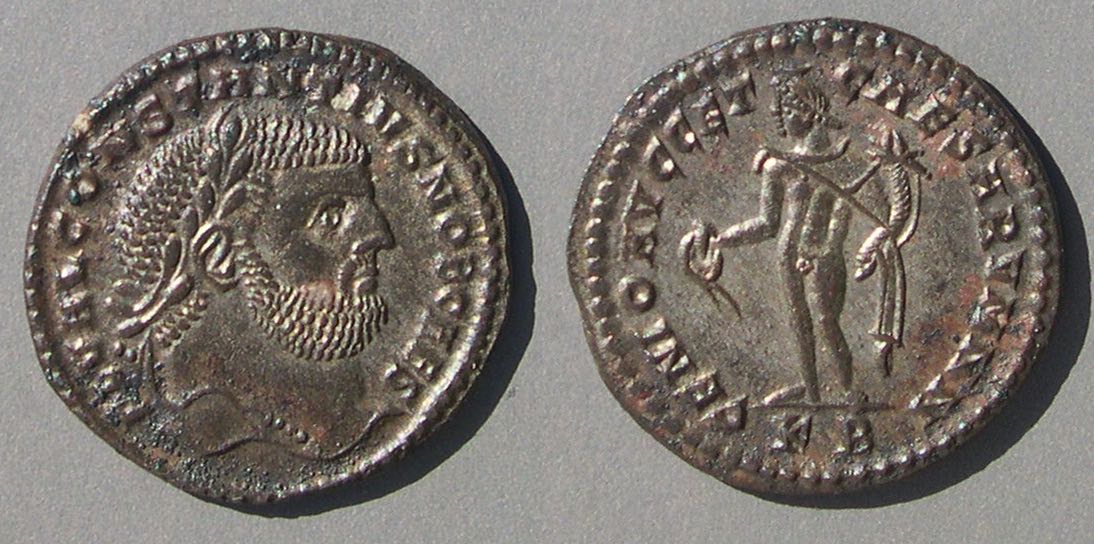
Constantius I
27 mm. 8.43 grams.
FL VAL CONSTANTIVS NOB CAES
Laureate head right
GENIO AVGG ET CAESARVM NN
Genius standing left, as on GENIO POPVLI ROMANI. Only the legend is different.
RIC Cyzicus 11a, "c. 297-299"
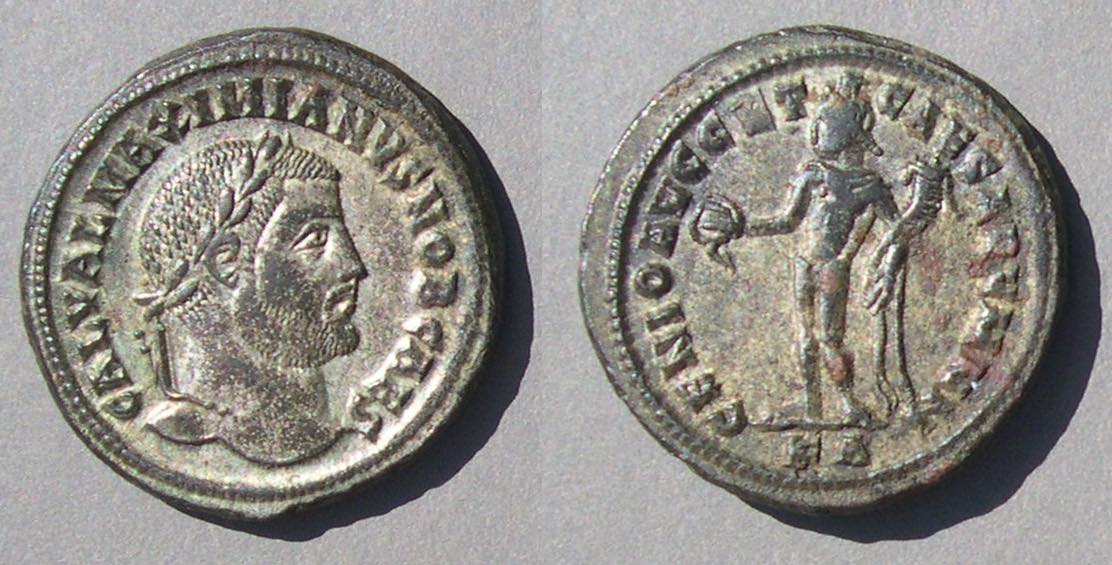
Galerius
28 mm. 11.97 grams.
GAL VAL MAXIMIANVS NOB CAES
Laureate head right
GENIO AVGG ET CAESARVM NN
Genius standing left.
RIC Cyzicus 96 "c. 295-6"
This type was also issued for the Caesars of the Second Tetrarchy.
Alexandria, Type 9. IOVI CONS CAES. Under the First Tetrarchy Diocletian was eastern Augustus and Galerius was eastern Caesar. Jupiter was their protecting god. This IOVI CONS CAES type was issued for both, but "CAES" in the reverse legend makes it more appropriate for Galerius. Under the Second Tetrarchy it was issued for Galerius as Augustus, but not for Maximinus II, the eastern Caesar.
![]()
Galerius
Follis. Silvered. 26 mm. 9.04 grams.
GAL VAL MAXIMIANVS NOB CAES
Laureate head right.
IOVI CO-NS CAES
Jupiter standing left holding Victory on globe and long staff, with cloak over his left shoulder.
ALE in exergue.
RIC VI Alexandria 43. Struck c. 304-5.
![]()
Diocletian
Follis. Silvered. 27 mm. 9.46 grams.
IMP C DIOCLETIANVS PF AVG
Laureate head right
IOVI CO-NS CAES
Jupiter standing left holding Victory on globe and long staff, with cloak over his left shoulder.
ALE in exergue.
RIC VI Alexandria 41 "c. 304-5"
This IOVI type was not issued for the Herculian rulers of the west.
Alexandria, Type 10. HERCVLI VICTORI. Under the First Tetrarchy Maximian was western Augustus and Constantius was western Caesar. Hercules was their protecting god. This HERCVLI VICTORI type was issued for both. Under the Second Tetrarchy it was issued for Constantius as Augustus, but not for Severus II, the western Caesar. (Under the Second Tetrarchy this type was minted at Siscia for Constantius and Galerius as Augusti and Maximinus II as Caesar.)
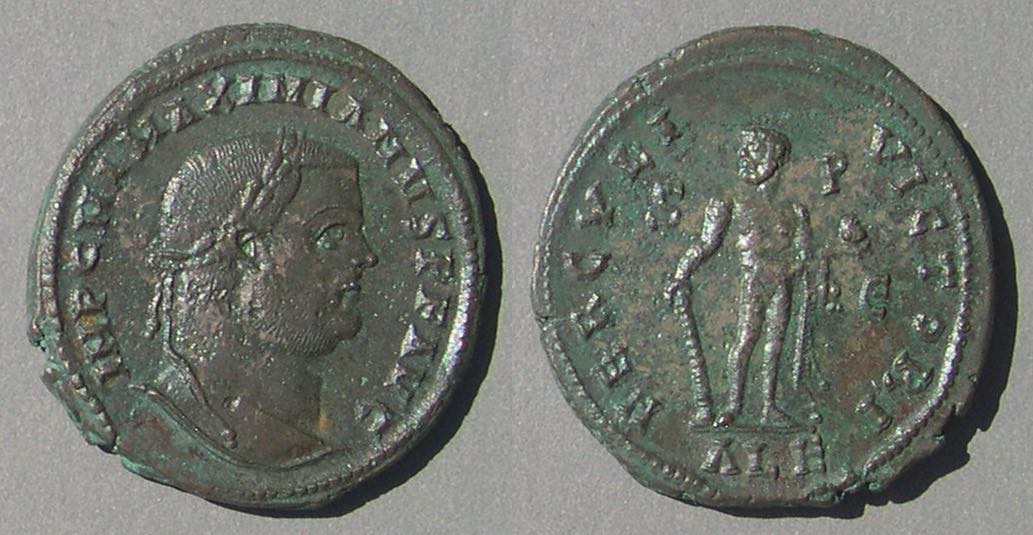
Maximian
Follis. 27 mm. 10.63 grams.
IMP C M A MAXIMIANVS PF AVG
HERCVLI VICTORI
Hercules standing, head left, leaning his right hand on his club and holding an apple in his left with his lion-skin hanging from his left arm
ALE in exergue
RIC VI Alexandria 38, struck "c. 304-5."
This HERCVLI type was not issued for the Iovian rulers of the east.
Other follis types after 305. All four members of the First Tetrarchy have other types of folles issued after the First Tetrarchy ended in 305. Diocletian and Maximian have retirement types and Maximian has types for his second reign. Constantius and Galerius have types issued after they became Augusti in 305.
The End
Return to the overview of the coins of the First Tetrarchy.
Go to a page of links to other pages on coins of the tetrarchies.
Go to the Table of Contents of this whole educational site.